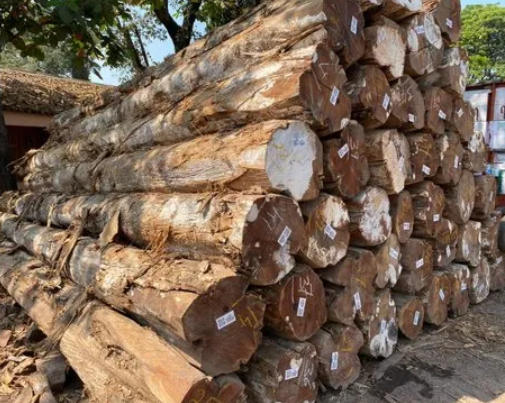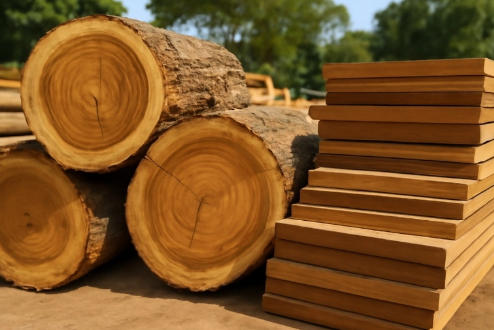










Content Menu
● What Makes Teak Wood Special?
● Teak Wood Grades: Grade A, B, and C Explained
>> Grade A Teak
● Origins of Teak: A Comprehensive Comparison
>> Burmese Teak (Myanmar Teak)
>> Indian Teak
>> South American and Brazilian Teak
>> Ghana Teak
● Color, Grain, and Texture by Type
● Real-World Applications for Each Teak Variety
● Advanced Teak Selection: Practical Insights
>> How to Choose the Right Teak for Your Needs
>> Common Pitfalls and How to Avoid Them
● Long-Term Value and Maintenance
● Environmental Impact and Certification
● Expert Recommendations & Future Trends
>> 1. What Is the Best Grade of Teak Wood?
>> 2. How Is Burmese Teak Different From Other Types?
>> 3. Is Plantation Teak a Good Option?
>> 4. How Can Genuine Teak Be Identified?
>> 5. What Are the Top Uses for Teak Wood?
Teak wood stands as the ultimate benchmark in the global timber industry, renowned for its unparalleled blend of elegance, strength, and resilience. Often called the “king of woods,” teak is treasured for superior performance in furniture, shipbuilding, construction, and décor. However, the selection is not straightforward—“teak” encompasses a rich diversity of grades, origins, and alternatives, each tailored for unique needs and budgets. This article delivers a deep dive into what makes teak so special, which varieties lead the industry, and how to select the best teak wood for your next project.[2][3][5]

The core appeal of teak lies in its naturally high oil and silica content, which imbues it with formidable resistance to water, insects, decay, and extreme climates. Its dimensional stability ensures minimal warping or splitting, even after decades of outdoor exposure. Moreover, the mature heartwood radiates a deep, golden brown, aging gracefully while retaining its structural integrity.[1][2]
Key characteristics:
- High natural oil and silica content
- Dense, straight, or subtly wavy grain patterns
- Exceptional hardiness against termites and fungal attack
- Distinctive, smooth, oily texture and leather-like scent
- Outstanding workability, but with some blunting of tools due to silica
Grade A teak is sourced from the heartwood of mature trees aged at least 30–50 years. This central portion is saturated with natural oils, lending it a dark, even golden-brown hue, fine straight grain, and supreme resistance to the elements. Grade A teak is prized for luxury indoor and outdoor projects, yacht decks, and premium furniture.[9][2]
- Grade B: Milled from the outer heartwood, slightly lighter in color, with a less uniform grain and lower oil content. It offers good, but reduced, durability. Suitable for mid-range furniture.[6][8]
- Grade C: Sourced from sapwood or immature trees; pale, soft, with an irregular open grain and minimal resistance to decay. Recommended only for cheap, low-stress, or decorative pieces.[6]
Burmese teak, sourced exclusively from the forests of Myanmar, represents the pinnacle of teak craftsmanship. Old-growth Burmese teak heartwood is exceptionally dense, fine-grained, rich in natural oils, and exhibits deep golden-brown color. It is respected for its micro-density zoning—the further inside the trunk, the denser and more valuable the boards.[3][5]
- Traits: Superior oil content, unmatched resistance to rot/insects, fine even grain, lasting color
- Applications: High-end yachts, historic restoration, luxury flooring & furniture[10][11][3]
- Availability: Scarce, expensive, subject to strict international trade regulations due to conservation efforts[5][3]
Thai teak is highly sought-after for its strength, stability, and deep coloration, ideal for exposed structural applications. Wild sources are nearly extinct, rendering genuine Thai teak rare and mostly used for restoration or temple construction.[4]
Indonesian (Asian) teak is grown on large, managed plantations—especially on Java. While generally lighter in hue and less resinous than its Burmese counterpart, it remains a solid mid-premium option, with sustainable practices often certified by the Forest Stewardship Council (FSC).[12][4][5]
- Key Features: Wide, straight grain, moderate oil content, light-brown to grey shade, more knots
- Uses: Quality indoor/outdoor furniture, building components, budgets requiring sustainable choices
- Sustainability: Plantation-grown, often with FSC certification, supporting responsible forestry[4]
Harvested from the subcontinent, Indian teak is renowned for its historic architectural use and remarkable strength. It displays a rich golden brown, although supply is limited and prices are high. Noted for exceptional hardness and resistance, it's often reserved for intricate joinery and iconic restoration work.[2]
- Highlight: Distinct golden color, high density, very expensive, used for high-value custom furniture[2]
While not a botanical teak, Iroko (Milicia excelsa) is marketed as “African teak” due to its similar appearance and performance. It is less dense and lower in oil, but much more affordable and easier to machine than true teak.[3][5]
- Attributes: Irregular grain, yellowish to brown color, moderate durability
- Typical Uses: Budget-conscious furniture, joinery, flooring, general construction
South American teak (Tectona grandis) is plantation-grown in Brazil and neighboring countries, maturing much faster due to rich rainfall. The rapid growth yields softer, lower density heartwood with reduced oil content, suitable for budget-friendly furniture and construction.[3]
- Note: Not to be confused with Brazilian “teak” (Cumaru), which is technically unrelated but offers high-density and color alternatives for flooring and decking.[3]
Ghana teak is an emerging plantation variant that closely mimics traditional Southeast Asian characteristics. It is noted for durability, a golden-brown color, and stable resistance to decay—ideal for buyers seeking an eco-friendly, reliable source.[5]
- Applications: Furniture, boatbuilding, general construction, especially in hot/humid climates

The heartwood of the best teak (Burmese, Thai, older Indian) exhibits a signature golden brown, darkening to rich caramel as it ages. Plantation teaks, like Indonesian and Ghanaian, are lighter brown, sometimes tinged grey or yellow, and tend to have wider, less consistent grains.[4][2][3]
- Burmese Teak: Deep gold to brown; extremely even, straight grain
- Indonesian Teak: Light to medium brown; wider, straight grain with occasional waviness
- African Teak (Iroko): Pale to yellow-brown; pronounced, irregular/interlocked grain
| Application Area | Recommended Teak Type | Why? |
|---|---|---|
| Yacht/Boat Decks | Burmese Grade A | Density, oil, stability |
| Restoration Projects | Thai, Indian, Philippine | Color match, tradition |
| Sustainable Furniture | Indonesian, Ghana Plantation | Eco, cost-effective |
| Budget Furniture | South American, Iroko | Affordability |
| Decorative/Joinery | Old Indian, Burmese | Fine detail, resilience |
1. Purpose: Consider end-use—outdoor durability (Burmese, Indonesian) versus indoor beauty (Indian, Grade A).
2. Grade Confirmation: Always confirm grade (A, B, or C)—visual color, grain uniformity, and documentation help verify.
3. Source Verification: Opt for FSC or government-certified sources for ethical, legal, and environmental responsibility.
4. Look for Aging Characteristics: Older, slow-grown teak will feature tighter grain and deeper color which translates into longer service life.[3]
- Don't trust “grade” claims without verification; many lower-grade woods are passed off as premium.
- Sapwood, often sold as Grade C, should be avoided in areas where rot/insect attack is likely.
- Imported Burmese teak may face customs or trade law restrictions; ensure paperwork is authentic and legal.[5]
Teak, properly maintained, can last 50–100+ years, especially in protected or moderate climates. Its value extends beyond price—teak furniture, flooring, and architecture regularly appreciate as they age, becoming more valuable for their patina and stability.
- Maintenance: Occasional cleaning, gentle sanding, and application of teak oil (optional) will keep pieces vibrant and protected.
- Aging Gracefully: Exposed teak develops a prestigious silver-grey patina, a sign of genuine and properly-seasoned teak; some prefer to retain golden tones with periodic oiling.
- Repairability: Damaged sections of teak can often be repaired and refinished with minimal loss of function or aesthetics.
Deforestation, illegal logging, and habitat loss have plagued some historic teak sources, especially in Myanmar. Today's most responsible buyers and suppliers prioritize wood with:
- FSC Certification: Ensures responsible forest management, legality, and worker welfare.
- Government Tracking: Particularly for plantation teak, helps guarantee origins and sustainable practices.
- Restoration Efforts: Some companies participate in replanting and conservation projects, especially in Africa and Southeast Asia.
Choosing plantation-grown teak, such as those from Indonesia, Ghana, or Brazil, is one of the best ways to reduce environmental impact while enjoying authentic teak quality.[4][5]
- Rise of Plantation Teak: Trend toward sustainable, plantation-grown Indonesian and African teak due to scarcity and regulations affecting Burmese and Thai forests.[5][4]
- Engineered and Composite Teak: For decking and flooring, new engineered products blend teak veneers with composite substrates, extending utility while conserving raw material.[5]
- Market Value: As old-growth Burmese becomes rarer, the value of certified, high-grade alternatives is rising for investors and legacy projects.
In summary, Burmese Grade A Teak remains the top choice for premium applications—its unrivaled oil content, grain density, strength, and color position it as the gold standard of luxury and resilience. For those needing sustainable and cost-effective solutions, plantation teaks from Indonesia and Ghana offer a compelling mix of durability and environmental consciousness, without sacrificing essential qualities. Always verify grade, origin, and certification to maximize investment value and ensure ethical stewardship—critical as teak markets evolve worldwide and resale value rises.[11][4][3][5]

Grade A teak, from mature tree heartwood, offers maximum oil, weather, and pest resistance—ideal for the most demanding and prestigious projects.[9][2]
Burmese teak features denser grain, deeper gold color, greater oil content, and elite durability—surpassing plantation and alternative species in luxury and marine use.[11][3][5]
Yes. Indonesian and Ghana plantation teak are sustainable, affordable, and retain much of the natural resilience of traditional teak, especially if sourced from slow-grown specimens.[4][5]
True teak is golden-brown, with a straight or subtly wavy grain, oily texture, and leather-like aroma. Demand FSC or legal certification to ensure authenticity.[1][5]
Its core areas include high-end outdoor/indoor furniture, yachts, flooring, historical restoration, and garden construction—thanks to unparalleled durability and elegance.[13][10][3]
[1](https://www.castlery.com/us/blog/how-to-identify-teak-wood)
[2](https://wknightconsulting.com/types-of-teak-wood/)
[3](https://atozwoodcompany.com/types-of-teak-wood/)
[4](https://www.bricknbolt.com/blogs-and-articles/buying-guide/teak-wood-types-and-costs)
[5](https://vinawoodltd.com/blogs/news/types-of-teak-wood)
[6](https://cameroontimberexport.com/types-of-teak-wood/)
[7](https://www.wood-database.com/teak/)
[8](https://leisuretouchrattan.com/different-grades-and-origins-of-teak/)
[9](https://aquateak.com/blog/grading-teak-wood/)
[10](https://usvintagewood.com/burmese-teak/)
[11](https://ahdfurniture.com/which-teak-wood-is-best/)
[12](https://www.facebook.com/groups/672818376463049/posts/2219998938411644/)
[13](https://www.hineighbor.com/blogs/the-journal/teak-outdoor-furniture-buying-guide)